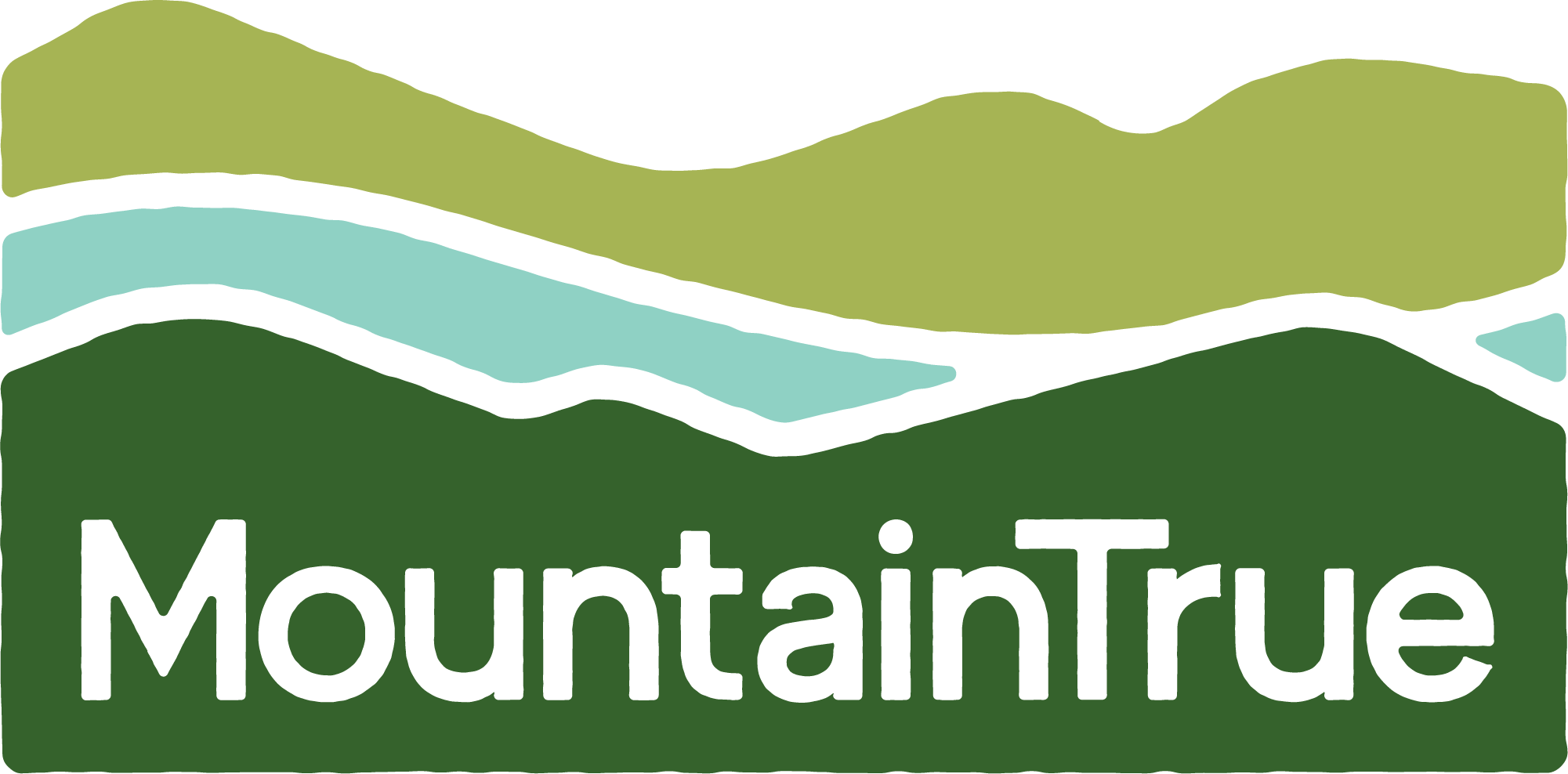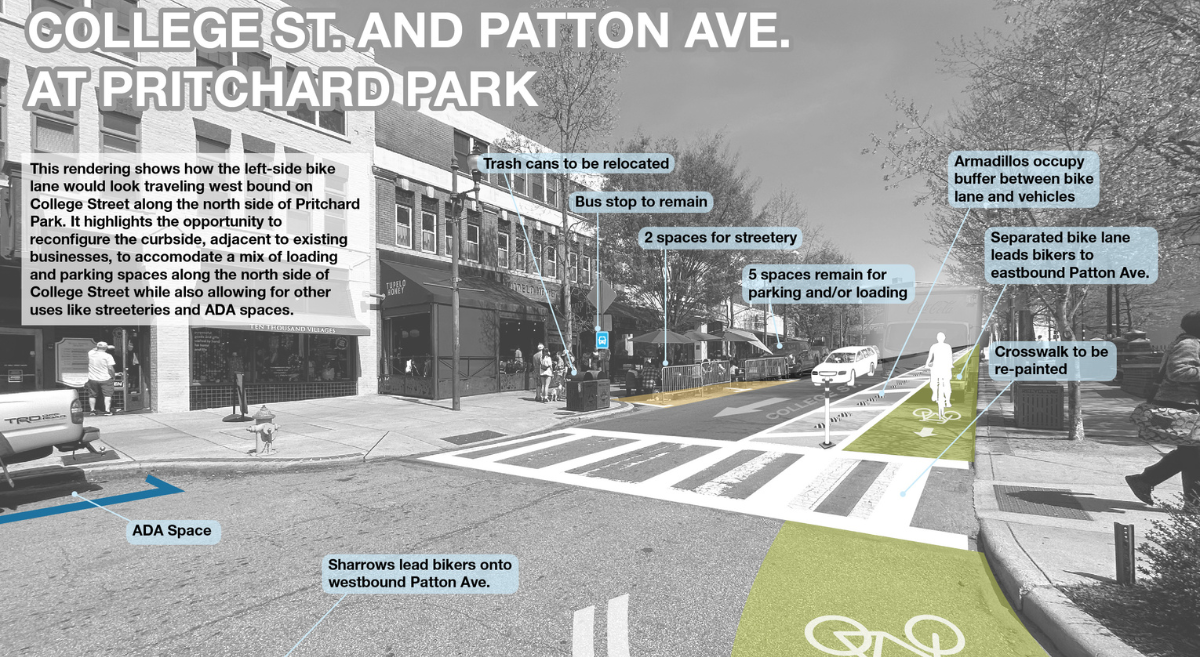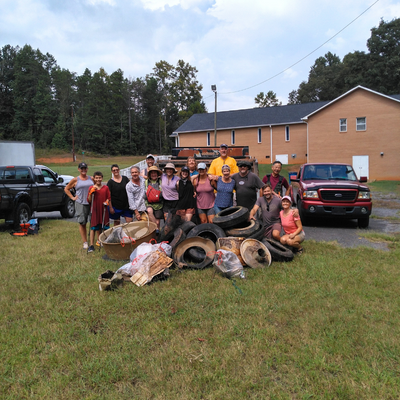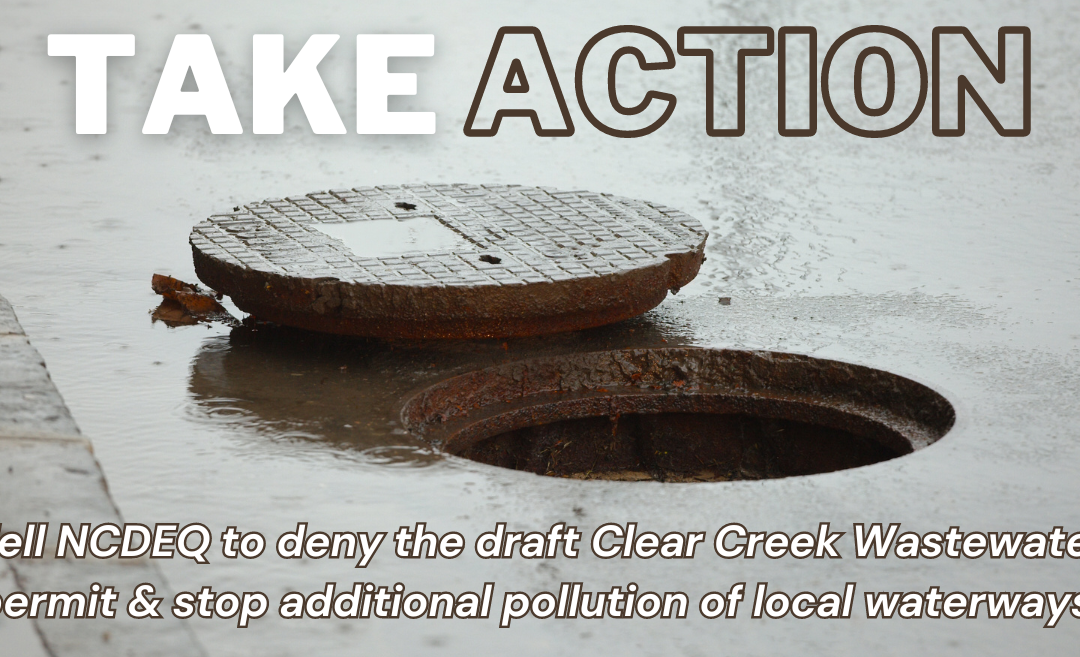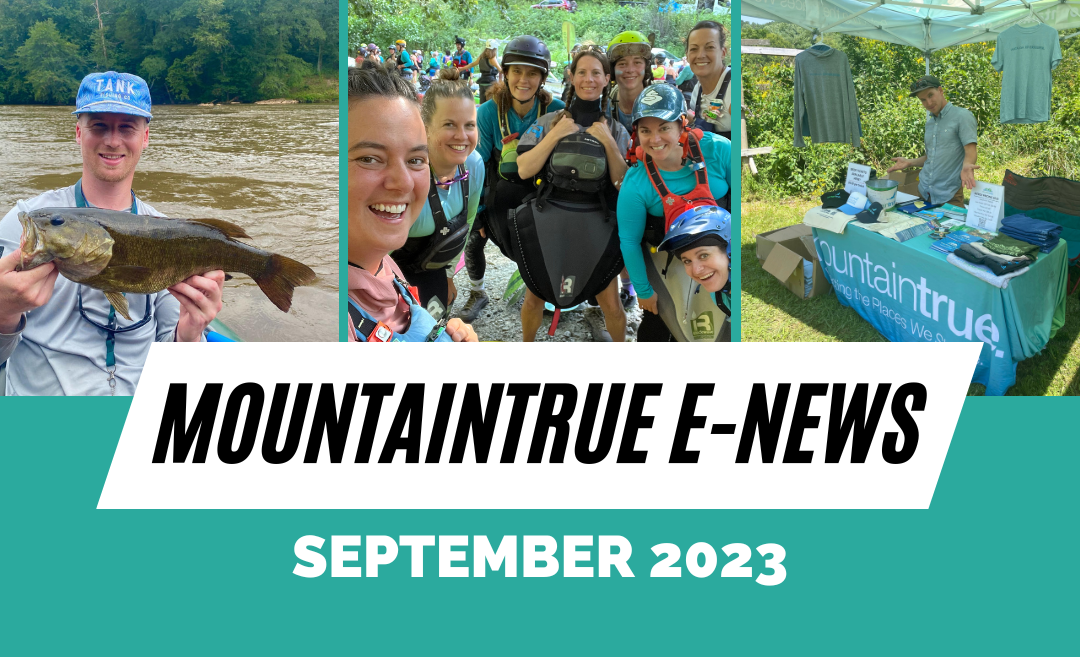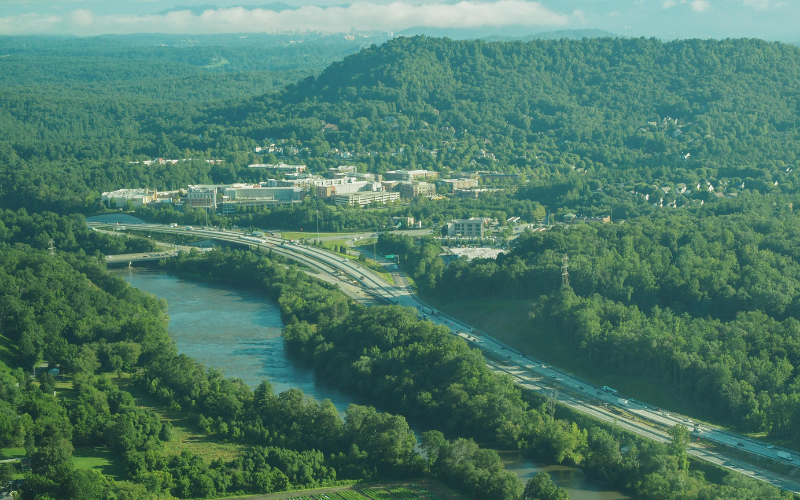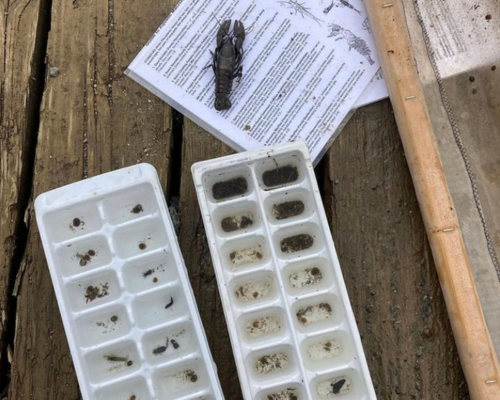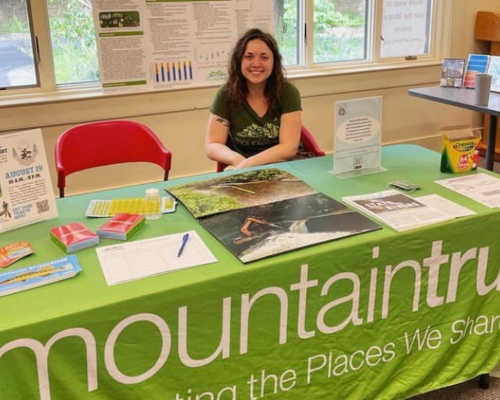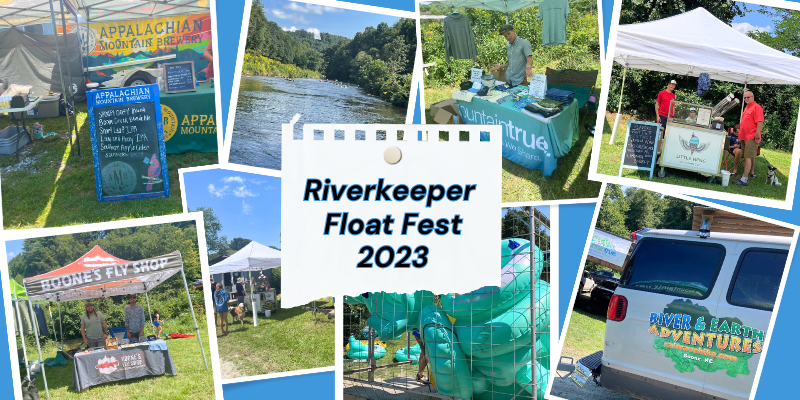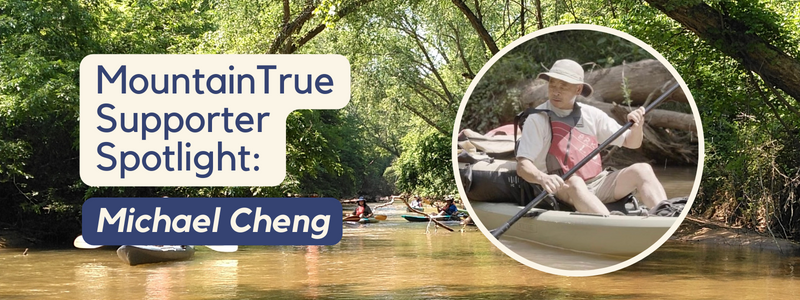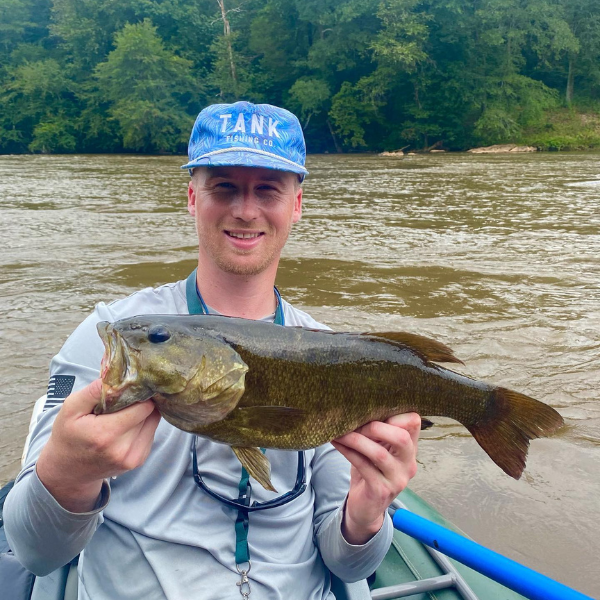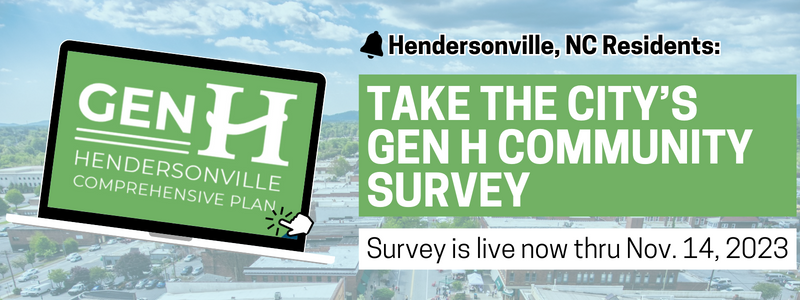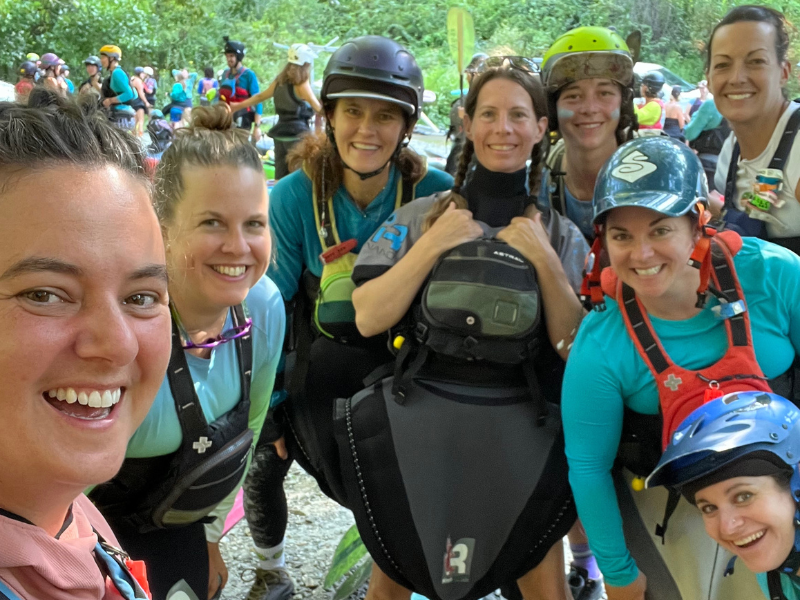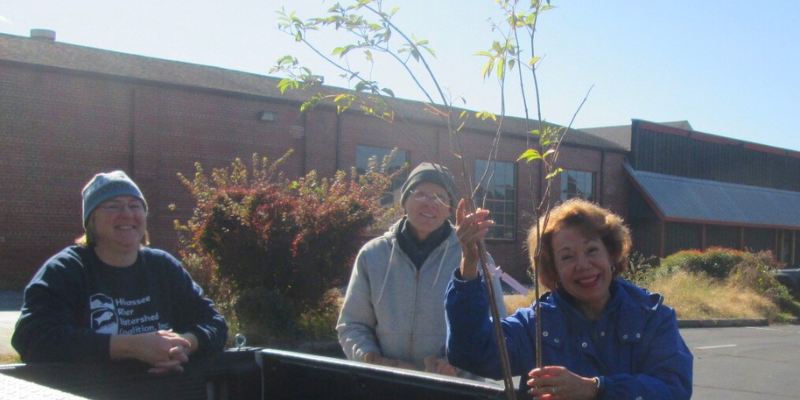
MountainTrue’s October 2023 E-Newsletter
MountainTrue’s
October 2023 E-Newsletter
October news from MountainTrue’s four regional offices:
Central Region News
Click here to read
High Country News
Click here to read
Southern Region News
Click here to read
Western Region News
Click here to read
Central Region News
A note from Bob Wagner, Executive Director:
I can’t help it; I like to win! Just ask any of our staff after a friendly game of kickball or wiffleball. I grew up playing, watching, and learning about sports. I learned the value of being a team as well as many other wonderful life lessons while doing my best to win.
Increasingly, however, I see that “winning at all costs” is a big part of our society’s problem. Our public rhetoric has become more incendiary. It’s a winner-take-all mentality. Many politicians — most of whom were elected by not much more than 50% of the vote — don’t see a need to listen to the nearly 50% of the people who didn’t vote for them. And, by definition, winners create losers. Losers aren’t happy, and will frequently subvert the winner. We need to do better, and there is another way.
The theme for MountainTrue’s Annual Gathering this past Saturday was We are all interconnected. We all need to do a better job of listening to each other, being willing to disagree but not vilify, debating ideas, and considering ways to accommodate diverse ideas in the solution. MountainTrue did this with 30 partners representing different interests when making a recommendation on the Nantahala Pisgah Forest Plan. We also engaged and included ideas from diverse stakeholders when making our anti-single-use plastics recommendation to Asheville and Buncombe County. Going forward, we remain committed to listening and bringing more people into the tent as we tackle the next big issue.
Pre-order your Save Our Endangered Forest Bats t-shirts today!
Proceeds from our “Save Our Endangered Forest Bats” t-shirt fund the work of MountainTrue’s Resilient Forests program, which works to ensure the Nantahala and Pisgah National Forests and the species that call it home are protected now and for future generations. Pre-orders accepted now through October 31. Order yours now!
The Endemic Species Pub Crawl returns on October 28
Join us at 5 p.m. on Saturday, October 28, to enjoy some tasty brews in South Asheville while dressed as your favorite endemic or native species! You don’t have to drink to join the pub crawl; come out to talk about endemic species with local experts and enthusiasts. All three locations (Hillman Beer, 7 Clans Brewing, and Village Pub) are dog-friendly, so feel free to coordinate your costume with your well-behaved pups and bring them along for this fun, free Halloween celebration! Need some costume inspiration? Click here to register + browse an extensive list of endemic flora and fauna species.
Save the Date: No Man’s Land Film Festival
MountainTrue is excited to once again present No Man’s Land Film Festival as part of GivingTuesday on Tuesday, November 28, at New Belgium Brewing in Asheville, NC. The films will be available both in-person and for virtual screening. Click here to find out more.
Join the MountainTrue team: Spring 2024 internships
We’re hiring one to two interns for our newest program, Neighbors for More Neighbors WNC (N4MN)! This position will begin in January 2024, with a flexible end date. The N4MN intern(s) will support program goals by creating social media content, conducting general program outreach, event planning, research on best practices in the pro-housing movement, and more. Click here to learn more + apply by October 30, 2023!
We’re also hiring a Healthy Communities Intern for spring 2024 — learn more + apply for this position here (application deadline is November 30).
Incoming bike lanes and pedestrian improvements in Downtown Asheville
We’re excited that Asheville City Council voted to move forward with multi-modal transportation improvements on College St. and Patton Ave. There was heated opposition to this project, and without the support of over 200 responders to our call to action, this project would have died despite years of studies, plans, and work to get it passed. Improvements like these create safer options for more users of our roads — including biking, walking, riding transit, or driving — and that paves the way for increased residential density in our city centers.
Neighbors for More Neighbors WNC supports Project Aspire
We believe that dense, multi-use development located in our city centers is part of the solution to meeting both our housing crisis and our climate crisis. Read our letter to Asheville City Council to learn about why we support Project Aspire on the Neighbors for More Neighbors WNC blog.
Hot Springs and the French Broad River
Come out to Pine Hall in Hot Springs at 7 p.m. on Tuesday, November 7, to hear MountainTrue’s French Broad Paddle Trail Manager, Jack Henderson, talk about access, stewardship, water quality, and partnerships focused on the French Broad River in and around Hot Springs and Madison County. Click here to learn more about this event sponsored by Friends of the Hot Springs Library.
Now streaming: The River Runs On
The River Runs On is finally available to stream online! Click here to watch the film — which features an interview with MountainTrue’s Public Lands Field Biologist, Josh Kelly — on Prime Video. Film description: Follow conservationists throughout Southern Appalachia as they struggle to manage two of the most important national forests in America – the Pisgah and Nantahala. The film revolves around a plan the US Forest Service is finalizing that will dictate how these two national forests are managed for the next twenty years. The result is a meditation on our relationship to nature.
Get out the vote: resources from the NC Conservation Network
NC voters can check out the NC State Board of Elections webpage to find out when local elections are happening in their communities. Municipal elections are critically important because we’ll be deciding on decision-makers such as mayors, school boards, and town council members. Here are some helpful resources:
- Find your county’s early voting locations and times here.
- Find your voter record online. Click here to check your registration, view a sample ballot, and locate your polling place for Election Day.
- A photo ID is now required to vote in NC, but there are exceptions! Click here to find out more.

Save the date: CCA Symposium
Mark your calendar for the Creation Care Alliance’s 2024 Winter Symposium, which will be held February 2-3 at the Montreat Conference Center in Black Mountain, NC. Early bird pricing, group and student discounts, as well as full scholarships will be available. Stay tuned for registration information coming soon!
Septic system repair grants available for qualifying property owners
MountainTrue has partnered with the North Carolina Department of Health and Human Services (DHHS) and local health departments to provide septic system repair grants to qualifying property owners in Buncombe, Cherokee, Haywood, Henderson, Macon, Madison, Mitchell, Transylvania, and Yancey counties, as well as several other counties across WNC. Residents of rural areas outside of town are highly likely to have onsite septic systems. Problems with septic systems usually arise as systems age or when maintenance is neglected. Property owners: click here to review eligibility requirements and apply for the repair program.
High Country News
A note from Andy Hill, High Country Regional Director & Watauga Riverkeeper:
It was so lovely to see many of you at our MountainTrue Annual Gathering in Asheville! Fall is here in the High Country, and we’re transitioning to our seasonal work projects. We enjoyed conducting habitat surveys with the NC Wildlife Resources Commission and App State during hellbender breeding season. Work is progressing nicely on our dam removal projects. We hope you can join us this season to plant some live stakes and treat some nonnative invasive plants. Keep reading to learn about our upcoming engagement opportunities and what else we’ve been up to.
Pre-order your Save Our Endangered Forest Bats t-shirts today!
Proceeds from our “Save Our Endangered Forest Bats” t-shirt fund the work of MountainTrue’s Resilient Forests program, which works to ensure the Nantahala and Pisgah National Forests and the species that call it home are protected now and for future generations. Pre-orders accepted now through October 31. Order yours now!
MountainTrue & the 105 Broadstone Bridge Replacement
We’ve been in consultation with the NC Department of Environmental Quality (NCDEQ) and NC Department of Transportation (NCDOT) on managing environmental impacts associated with 105 Bridge Replacement. MountainTrue has been engaged in advocacy on this project for over a decade, from its first inclusion in the State Transportation Improvement Program (STIP) to the current Best Fit Alternative. We’ll continue to monitor this project. Monitoring hellbender populations and fitting individuals with pit tags for long-term monitoring has been an exciting part of this project. Click here to learn more.
Field investigation update:
In the first test of the new Watauga River watershed water quality standards, which took effect on September 1, MountainTrue Watershed Outreach Coordinator Hannah Woodburn uncovered a major sewage violation on Shawneehaw Creek. Her investigation revealed an illicit discharge of untreated human waste into a tributary of the Watauga River designated as Outstanding Resource Waters. Violators were fined by NCDEQ, and remediation of the failing wastewater treatment system was brought up to state standards. Enforcement of the Clean Water Act is a top priority of our Riverkeeper program and is made possible by your support. We were thrilled to see swift action taken by NCDEQ to protect this beloved trout stream.
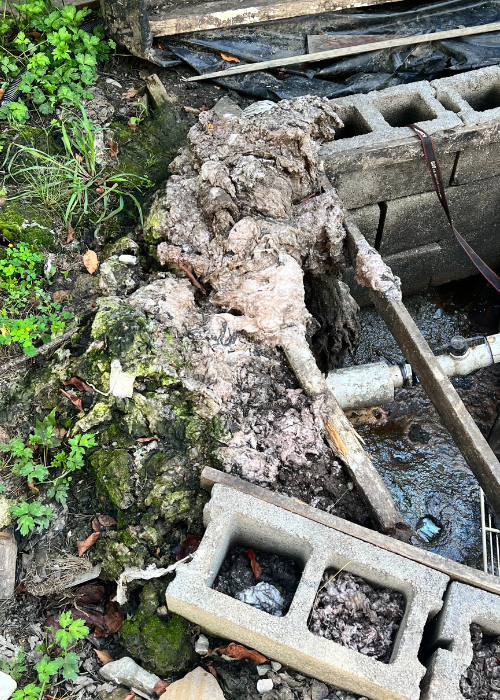
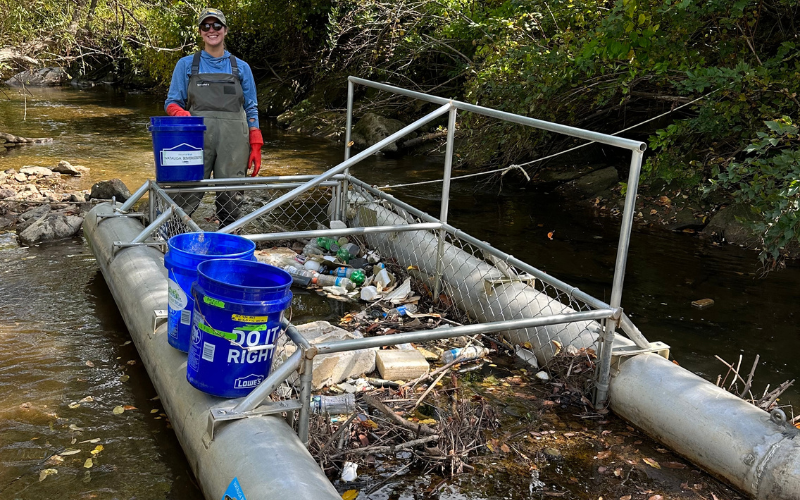
Photo: Hannah Woodburn poses for a photo behind the Middle Fork Trash Trout.
Middle Fork Trash Trout update
The Watauga Riverkeeper team ventured out to the Middle Fork Trash Trout for maintenance and a cleanout this month to ensure its preparedness for the upcoming cold season. Some significant trees, limbs, and brush created flow issues and put the Trash Trout in need of a little TLC. We’re happy to report that it’s back in action and functioning properly! Trash Trout cleanouts allow us to keep tabs on the amount of macroplastics flowing through our rivers and help our downstream neighbors a bit in the process!
Fall + winter live staking in the High Country
As cooler weather starts to move in, our team is getting ready for live staking season! Join us outside this season to help restore and replenish streambanks while meeting new friends and doing some good work for Mother Nature. Live staking involves taking dormant cuttings of a living tree and planting them along the river’s edge. Join us on Friday, November 17, and December 15, from 10 a.m. to 2 p.m. (location TBD). Email Hannah (hannah@mountaintrue.org) or Emma (hcrointern@mountaintrue.org) for more information!
Save the Date: No Man’s Land Film Festival
MountainTrue is excited to once again present No Man’s Land Film Festival as part of GivingTuesday on Tuesday, November 28, at New Belgium Brewing in Asheville, NC. The films will be available both in-person and for virtual screening. Mark your calendars and stay tuned for more details coming soon.

Photo: Emma Crider (left) and Hannah Woodburn (right) pose for a fun photo at AMB’s 2023 Oktoberfest.
Good times at AMB Oktoberfest
This year’s Oktoberfest at Appalachian Mountain Brewery was the best one yet! Brats + beer + meeting new friends = a fantastic day! We were able to spend the day alongside other amazing nonprofit organizations and spread the word about our goals, upcoming events, and community partnerships that help us protect our watershed. With perfect weather for games and outdoor fun, it was nothing short of a perfect day. Thank you to our AMB family for hosting such a fun event!
Turtle Island Preserve stream lesson
Last month, Hannah and Emma spent a day teaching a homeschool group about their watershed at Turtle Island Preserve. It was a beautiful day to experience the natural living experience the space provides for people of all ages. We played with horses, explored a tributary of the South Fork New River, and discussed the processes and challenges of our watershed. The children were so knowledgeable and curious; obviously little scientists in the making! Thank you to all of our Turtle Island friends for having us.

Photo: A serene scene from the recent Watauga Tailwaters guided paddle.
A summer send-off on the Watauga Tailwaters
Hannah led our annual tailwaters paddle trip in September, which was absolutely wonderful! We had a great turnout and even better weather to soak in the last bit of summer. We’re so thankful for fun days on the water with our river family, taking time to appreciate our awesome watershed. A huge thank you to all those who could come and hang out with us!
Now streaming: The River Runs On
The River Runs On is finally available to stream online! Click here to watch the film — which features an interview with MountainTrue’s Public Lands Field Biologist, Josh Kelly — on Prime Video. Film description: Follow conservationists throughout Southern Appalachia as they struggle to manage two of the most important national forests in America – the Pisgah and Nantahala. The film revolves around a plan the US Forest Service is finalizing that will dictate how these two national forests are managed for the next twenty years. The result is a meditation on our relationship to nature.
Get out the vote: resources from the NC Conservation Network
NC voters can check out the NC State Board of Elections webpage to find out when local elections are happening in their communities. Municipal elections are critically important because we’ll be deciding on decision-makers such as mayors, school boards, and town council members. Here are some helpful resources:
- Find your county’s early voting locations and times here.
- Find your voter record online. Click here to check your registration, view a sample ballot, and locate your polling place for Election Day.
- A photo ID is now required to vote in NC, but there are exceptions! Click here to find out more.

Save the date: CCA Symposium
Mark your calendar for the Creation Care Alliance’s 2024 Winter Symposium, which will be held February 2-3 at the Montreat Conference Center in Black Mountain, NC. Early bird pricing, group and student discounts, as well as full scholarships will be available. Stay tuned for registration information coming soon!
Southern Region News
A note from Nancy Díaz, Southern Regional Director:
Cool, crisp weather is finally here, and it’s time to bring out the flannel! Our autumn forests teach us how beautiful it can be to let some things go; I hope this season brings a lot of peaceful reflection to your life. Something we haven’t let go of and are eager to resume is our Hendersonville Green Drinks Series! I appreciate Mike Huffman, Trailside Brewing Company, and Conserving Carolina for their roles in the successful first lecture of this series. Read on for details about next month’s lecture at Trailside Brewing Co.

Photo: Mike Huffman, Stormwater Division Manager for the City of Hendersonville, speaks to the crowd at the first Green Drinks of 2023 on October 12.
While coordinating the return of Hendersonville Green Drinks, I learned that Green Drinks started in London in 1989 and currently exists in over 500 cities globally, with international events coordinated through greendrinks.org. I look forward to seeing you at future Green Drinks presentations and supporting efforts throughout our region to create more spaces to learn and express our interests in protecting the places we share.
Happy fall, and happy learning!
Pre-order your Save Our Endangered Forest Bats t-shirts today!
Proceeds from our “Save Our Endangered Forest Bats” t-shirt fund the work of MountainTrue’s Resilient Forests program, which works to ensure the Nantahala and Pisgah National Forests and the species that call it home are protected now and for future generations. Pre-orders accepted now through October 31. Order yours now!
Float down the Broad River with us this weekend
Join Broad Riverkeeper David Caldwell this Saturday, October 21, for a fall float along the Broad River in Shelby, NC. We’ll paddle and float down a beautiful and remote stretch of the Broad that few people get to enjoy! The first half of the trip will have some fun, easy class I and II rapids. The second half of this section is slow-moving and still water, so we’ll need to paddle some (not just float) to reach the takeout on time. This guided adventure will last approximately four to five hours. If interested, we invite you to bring a fishing pole and binoculars on this trip, as there will be opportunities to fish and see wildlife! Click here to learn more and register.
Come out to the Broad Riverkeeper Open House on October 26
MountainTrue and Biz Hub invite you to learn more about the Broad Riverkeeper Program at this casual drop-in event in Shelby, NC! We’ll be serving food from 4:30-6:30 p.m., with a short program at 5:30 p.m. to hear from your Broad Riverkeeper, David Caldwell; MountainTrue’s Southern Regional Director, Nancy Díaz; and Biz Hub’s Jeff and Julie Weathers. The Broad River Watershed includes 5,419 square miles within both North and South Carolina. The Broad River Basin includes Five Natural Heritage Program Priority Areas: the Rollins/South Mountains Natural Area, Hickory Nut Gorge, the Green River Gorge, the Pacolet River Gorge, and Pinnacle Mountain. These areas provide habitat for more than 100 rare plant and animal species and 24 rare natural communities. Join us in being a part of preserving this important local natural resource! RSVP by Monday, October 23, 2023.
Join us at Trailside Brewing Co. for Hendersonville Green Drinks this Fall
Join us at Trailside Brewing Co. on Thursday, November 9, in Hendersonville, NC, for an informative session led by retired MountainTrue ecologist Bob Gale. At this event, Bob will discuss issues related to nonnative invasive plants, methods of control, and ideas for moving your yard toward a more natural ecosystem. Click here to learn more.
Hendersonville Green Drinks is presented by MountainTrue, Conserving Carolina, and Trailside Brewing Co. We’re thankful to our gracious hosts, Trailside Brewing Company! Come to Green Drinks to learn more about current environmental issues, have relevant discussions, and meet with like-minded people. This is a monthly event and everyone is welcome — you don’t have to drink at Green Drinks, just come and listen! Trailside Brewing Co. offers beer, wine, cider, prosecco and non-alcoholic beverages. A limited food menu will be available.
Photos: Sarah Sweep volunteers enjoying each other’s company and showing the First Broad some love by removing river trash (left). Sarah Sweep volunteers pose for a photo with their impressive haul of river trash (right).
The 8th Annual Sarah Sweep was one for the books!
Mother Nature must have known our crew’s good intentions for the First Broad River and our community at the 8th Annual Sarah Sweep last month; she held back the thunderstorms that the weatherman promised, and we had a lovely day on and off the water. Fifteen volunteers on the water removed a dump truckload’s worth of tires and garbage from the First Broad River! We then returned to Double Shoals Cotton Mill for an evening of good food, friends, and local music.
Save the Date: No Man’s Land Film Festival
MountainTrue is excited to once again present No Man’s Land Film Festival as part of GivingTuesday on Tuesday, November 28, at New Belgium Brewing in Asheville, NC. The films will be available both in-person and for virtual screening. Mark your calendars and stay tuned for more details coming soon.
Join the MountainTrue team: Spring 2024 internships
We’re hiring one to two interns for our newest program, Neighbors for More Neighbors WNC (N4MN)! This position will begin in January 2024, with a flexible end date. The N4MN intern(s) will support program goals by creating social media content, conducting general program outreach, event planning, research on best practices in the pro-housing movement, and more. Click here to learn more + apply by October 30, 2023!
We’re also hiring a Healthy Communities Intern for spring 2024 — learn more + apply for this position here (application deadline is November 30).
Clear Creek Wastewater Discharge Permit – comments submitted
Last month, NCDEQ shared a draft wastewater discharge permit and held a public comment period for a new proposed Henderson County Clear Creek Wastewater Treatment Plant. Clear Creek is a tributary to Mud Creek that ultimately flows into the French Broad River and is listed as impaired on the state’s 303(d) list of impaired streams. Henderson County is proposing construction of a new wastewater treatment plant and expansion of sewer service to the Edneyville area. MountainTrue is opposed to this permit because a new discharge to an impaired stream is unlawful and construction of a new wastewater treatment plant is unnecessary given the option available to connect to the existing plant operated by the City of Hendersonville. However, any sewer expansion to this part of Henderson County could open the doors to sprawling development, so appropriate land use protections need to be implemented before facilitating unchecked development. Thank you to those of you who submitted comments through our action alert (tag alert). MountainTrue also submitted technical comments with support from the Southern Environmental Law Center, and we will continue to monitor this issue. If you have any questions, please contact Nancy Diaz (nancy@mountaintrue.org).

Photo: The NC Danza Chichimeca poses for a photo on the French Broad Riverkeeper canoe after a spirited performance.
Many thanks to our community partners
A few weeks ago, FIND Outdoors hosted the first Latino Heritage Festival at the Cradle of Forestry; the new Appalachian Mountain Brewery – Mills River location held an Oktoberfest celebration and community fundraiser; the UU Fellowship of Hendersonville invited us to be a part of their program; and Trinity Presbyterian of Hendersonville hosted a screening of The River Runs On documentary. We’re so thankful to the many wonderful partners who support our mission and give us opportunities to engage with new audiences in an effort to build our MountainTrue community, and we extend a warm welcome to the new folks who have joined our network!
Now streaming: The River Runs On
The River Runs On is finally available to stream online! Click here to watch the film — which features an interview with MountainTrue’s Public Lands Field Biologist, Josh Kelly — on Prime Video. Film description: Follow conservationists throughout Southern Appalachia as they struggle to manage two of the most important national forests in America – the Pisgah and Nantahala. The film revolves around a plan the US Forest Service is finalizing that will dictate how these two national forests are managed for the next twenty years. The result is a meditation on our relationship to nature.
Get out the vote: resources from the NC Conservation Network
NC voters can check out the NC State Board of Elections webpage to find out when local elections are happening in their communities. Municipal elections are critically important because we’ll be deciding on decision-makers such as mayors, school boards, and town council members. Here are some helpful resources:
- Find your county’s early voting locations and times here.
- Find your voter record online. Click here to check your registration, view a sample ballot, and locate your polling place for Election Day.
- A photo ID is now required to vote in NC, but there are exceptions! Click here to find out more.

Save the date: CCA Symposium
Mark your calendar for the Creation Care Alliance’s 2024 Winter Symposium, which will be held February 2-3 at the Montreat Conference Center in Black Mountain, NC. Early bird pricing, group and student discounts, as well as full scholarships will be available. Stay tuned for registration information coming soon!
Septic system repair grants available for qualifying property owners
MountainTrue has partnered with the North Carolina Department of Health and Human Services (DHHS) and local health departments to provide septic system repair grants to qualifying property owners in Buncombe, Cherokee, Haywood, Henderson, Macon, Madison, Mitchell, Transylvania, and Yancey counties, as well as several other counties across WNC. Residents of rural areas outside of town are highly likely to have onsite septic systems. Problems with septic systems usually arise as systems age or when maintenance is neglected. Property owners: click here to review eligibility requirements and apply for the repair program.
Take this survey to let Hendersonville know your priorities for the future
The City of Hendersonville is developing its 2045 Comprehensive Plan to establish a long-term vision for sustainable growth and conservation. The Comprehensive Plan is called Gen H to encourage the community to think generationally about the future of Hendersonville. The Gen H Community Survey is the first opportunity for the public to provide input. The survey is open through November 14 and is an excellent opportunity to share your ideas for Hendersonville’s future. Read our recommendations and take the survey here.
The Hendersonville Public Works department is updating their master plan too, take the Parks & Greenspace Survey! (Open thru December 2023)
Western Region News
A note from Callie Moore, Western Regional Director:
Many of you summer lovers won’t share my enthusiasm for October. I love all seasons, but I get really happy when the ragweed dies and the leaves start to fall. In my opinion, it’s perfect hiking weather! And it often means we might see some snow soon. (My colleague, Tony, is groaning right now.) Our on-the-ground work here in the Western Region shifts away from summer E. coli sampling and more towards habitat restoration and invasive plant removal. However, with your help, our advocacy work continues as strong as ever. Emily Bronte shared my view of the season:
Fall, leaves, fall by Emily Brontë
Fall, leaves, fall; die, flowers, away;
Lengthen night and shorten day;
Every leaf speaks bliss to me
Fluttering from the autumn tree.
I shall smile when wreaths of snow
Blossom where the rose should grow;
I shall sing when night’s decay
Ushers in a drearier day.
Happy fall, y’all!
Pre-order your Save Our Endangered Forest Bats t-shirts today!
Proceeds from our “Save Our Endangered Forest Bats” t-shirt fund the work of MountainTrue’s Resilient Forests program, which works to ensure the Nantahala and Pisgah National Forests and the species that call it home are protected now and for future generations. Pre-orders accepted now through October 31. Order yours now!
Cherokee County, NC adopts first comprehensive plan, places moratorium on high impact land uses
The Cherokee County commissioners have taken positive and historic steps in recent weeks to protect residential communities from the establishment of more cryptocurrency mining operations and other high-impact land uses. On September 18, Cherokee County adopted its first-ever comprehensive land use plan, establishing a baseline by which private property rights can be balanced with community character. On October 2, the commissioners adopted a moratorium on certain high-impact land uses while they work to develop an ordinance that would provide limitations for these uses in the future. MountainTrue Western Regional Director Callie Moore spoke in favor of the moratorium at the public hearing, applauding the county’s efforts to develop an ordinance requiring a closer look at new and expanding high-impact commercial and industrial operations, including cryptomines. MountainTrue has been working behind the scenes with county residents and partner organizations to push for these changes since the unenclosed Harshaw Road cryptomine came online in the fall of 2021.
Photo: Parrot feather infestation in the south end of Lake Chatuge near the US Hwy. 76 bridge in Towns County, Georgia.
Controlling nuisance aquatic weeds in the headwaters of Lake Chatuge
For the last two summers, noxious weeds have been an unwelcome presence on the south side of Lake Chatuge in and around the Macedonia area of Towns County, Georgia. The primary culprit, parrot feather (Myriophyllum aquaticum), is native to tropical parts of South America, Australia, and New Zealand. Despite its highly invasive tendencies in natural waters, it’s still actively promoted and sold for use in ponds and aquariums and has been accidentally introduced to waterways all over the US from these sources. Like many invasive aquatic species, parrot feather can also be transferred to waters on boats and other watercraft. Flourishing in warm water conditions, it grows rapidly in late spring and summer, creating huge mats of rooted vegetation that can cause recreational and navigational issues. Learn more about what TVA is doing and recommending to homeowners here.
Fall volunteer opportunities on the Jackson County Greenway
MountainTrue is again hosting a series of community volunteer workdays this fall to control nonnative invasive plants and restore native habitat at the Jackson County Greenway in Cullowhee, NC. Our partners for these events include Jackson County Parks & Recreation, Mainspring Conservation Trust, and the WCU Center for Community Engagement and Service Learning. We’ll pull up roots, cut vines, and use hand tools to remove invasive shrubs (like Chinese privet) and then treat the stumps. No prior experience is necessary; we’ll provide tools and training. Please register in advance so that we’ll have enough tools, gloves, etc. We have large and small tasks available, so you don’t have to be able to do strenuous physical labor to participate. Please, no pets. Email AmeriCorps service member Eve Davis with any questions.
Photo: Benjamin Davis won the prize for Most Creative Trash Photo in 2020.
13th Annual Lake Chatuge Shoreline Cleanup: Saturday, November 4
Join other lake-loving volunteers on Saturday, November 4, for the 13th Annual Lake Chatuge Shoreline Cleanup, sponsored by Tennessee Valley Authority & Georgia Rivers Alive. The event will kick off at 9 a.m. at the Towns County Swim Beach Pavilion across from the Georgia Mountain Fairgrounds where volunteers will get their assigned cleanup locations and be given bags, gloves, and safety information. Coffee and grab-n-go breakfast snacks will be available, along with free Rivers Alive t-shirts for the first 30 volunteers. After two hours of shoreline cleaning at assigned sites, volunteers will meet back at the pavilion at 11:30 a.m. for prizes. Three prizes will be given on the day of the cleanup: Most Trash Collected by a Group, Most Creative Trash Photo, and Most Unique Trash Item Found. Please register yourself or your group so we’ll know you’re coming.
Live closer to Fontana Lake? The annual Fontana Lakeshore Cleanup sponsored by Fontana Village Marina is also the first weekend in November. Email AmeriCorps service member Eve Davis for details.
Order native trees and shrubs through November 5
There’s still time to order native plants during our 7th Annual Fall Native Tree Sale Fundraiser! Choose from 30 native species, ranging from large shade trees to smaller ornamental shrubs. All plants are quality nursery stock and are available in one to three-gallon pots. Click here to place your orders by November 5, 2023. A few species are nearly sold out, so place your order today! Please note: Your plants must be picked up between 9 a.m. and 12 p.m. on Saturday, November 18, at the MountainTrue West office parking lot in Murphy, NC.
Now streaming: The River Runs On
The River Runs On is finally available to stream online! Click here to watch the film — which features an interview with MountainTrue’s Public Lands Field Biologist, Josh Kelly — on Prime Video. Film description: Follow conservationists throughout Southern Appalachia as they struggle to manage two of the most important national forests in America – the Pisgah and Nantahala. The film revolves around a plan the US Forest Service is finalizing that will dictate how these two national forests are managed for the next twenty years. The result is a meditation on our relationship to nature.
Get out the vote
Municipal elections are critically important because we’ll be deciding on decision-makers such as mayors, school boards, and town council members. Here are some helpful resources:
NC voters: check out the NC State Board of Elections webpage to find out when local elections are happening in your communities.
- Find your county’s early voting locations and times here.
- Find your voter record online. Click here to check your registration, view a sample ballot, and locate your polling place for Election Day.
- A photo ID is now required to vote in NC, but there are exceptions! Click here to find out more.
GA voters: click here to check out this one-stop-shop for voting resources on the Georgia Secretary of State website.

Save the date: CCA Symposium
Mark your calendar for the Creation Care Alliance’s 2024 Winter Symposium, which will be held February 2-3 at the Montreat Conference Center in Black Mountain, NC. Early bird pricing, group and student discounts, as well as full scholarships will be available. Stay tuned for registration information coming soon!
Septic system repair grants available for qualifying property owners
MountainTrue has partnered with the North Carolina Department of Health and Human Services (DHHS) and local health departments to provide septic system repair grants to qualifying property owners in Cherokee and Haywood counties, as well as several other counties across WNC. Residents of rural areas outside of town are highly likely to have onsite septic systems. Problems with septic systems usually arise as systems age or when maintenance is neglected. Property owners: click here to review eligibility requirements and apply for the repair program.
